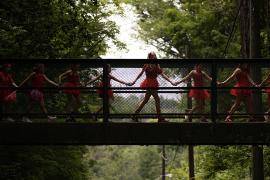Where is our hope? Does it lie in the group of ten-year-olds turning over rocks to peer underneath, exploring caves, and running along streams where trout skim the rippling water's surface? Does it settle down around the campfire in the evening when staff and campers commune while they tell exciting stories of courage or funny episodes of the day? Or, does it wrap itself around the fifteen teens who triumphantly climbed an 18,000-foot peak? Camp continues to build hope in the most innocent of places, a child's heart. The camp experience strengthens the fragile, encourages the shy, and awakens the adventurous spirits that dwell in each child.
The American Camp Association has identified Three Pillars of Hope that are achieved through quality camp-related youth development programs. Every child through a valueenriched camp experience encounters 1) intimacy with nature; 2) authentic human connections; and 3) human-powered activities. These Three Pillars of Hope come alive at camp . . . .
Intimacy With Nature
At Green River Preserve deep in the Blue Ridge Mountains, children enjoy the art of discovery as they experience the camp's 3,400-acre wildlife preserve in Cedar Mountain, North Carolina. "Nature is the uniting element of our camp," explains Paul Bockoven, camp director. "Every day small groups of campers go out on mentor hikes with professional naturalists where they learn to identify wild edibles, find water falls, and become immersed in the environment."
Connections with nature balance the pace of children's lives at Green River Preserve. Modern life speeds by leaving no time to absorb your surroundings. "Nature intrinsically," says Bockoven, "keeps you at nature's pace. It teaches campers patience. Some things you can't see on the spur of the moment, like the flower blooming or the finch you are waiting to see alight in a tree." Nature gives us time — time to listen to our internal dialogue.
Incorporating connections to nature in every day camp experiences is a simple process of focusing time and awareness of nature in almost any outdoor activity. Bockoven recommends looking at and talking about your surroundings when you are holding activities outside. Set brief time aside for exploration. "Learning about nature doesn't have to be an academic subject. You don't have to identify every animal and plant, just motivate the kids to ask questions and appreciate their surroundings."
Why should camps incorporate nature connections into camp programming? "Providing nature education leads to environmentally literate adults," states Patti Steinman, camp director for Arcadia Nature Day Camp, "who are able to make wise decisions about environmental issues."
Surrounded by Arcadia Wildlife Sanctuary in Easthampton, Massachusetts, children ages four to twelve participate in Arcadia Day Camp activities from 9 a.m. to 3 p.m. every day in one to two-week sessions. Children experience ponding, bird walks, and nature journaling. "When we go ponding, we use nets to catch macroinvertebrates and to a lesser extent amphibians. We use nets during fielding, too. We are careful with the environment. It's very important to put things back the way we found them. We teach low-impact skills. Our counselors are the facilitators to learning; nature is the teacher. We hope to inspire children to want to learn more about the environment."
Programming Ideas
- Human Camera — Pair campers in groups of two. One camper partner gently guides the other partner, who has his/her eyes closed, a few paces on the trail. The guiding partner taps the other camper on the shoulder. This is a signal for the camper to open his/ her eyes for a few seconds and close them again, making a mental picture of what glimpse of nature he/she has seen. Do this several times and then switch roles. After the activity, gather the campers together and talk about their favorite "mental" photos of nature they witnessed. What did they see? Did they focus on a tiny flower or look up at a tree and see the leaves? This is an activity that gets campers to stop and look.
- Micro Hike — Give each camper a ruler or piece of string. Take the campers on a brief hike. At a certain point in the hike, tell campers to place the ruler/string on the ground, next to a tree, or anywhere along the trail. Ask them what they see around the ruler . . . anything decomposing? New? Any insects? Nests? The Micro Hike helps guide campers to a small area of nature in which they can focus their view of the environment.
Contributed by Paul Bockoven, Green River Preserve
Authentic Human Connections
Children play in the woodland forest, are refreshed by a mountain stream, and marvel at a 45-foot waterfall on Camp Glisson's property in Dahlonega, Georgia, and while nature surrounds them, the young leaders and mentors at Camp Glisson empower them. "The camp experience is uniquely transformative. If we are to be transformative, personally and socially, we need to pay attention to how our staff can be mentors and team leaders. We must provide them with examples as to how they can engage children," explains C. Russell Davis, camp director for Camp Glisson.
The transformative power of camp begins in the relationship building and role modeling that takes place. "Mentoring is part of our culture," says Davis. "It's an expectation that staff will have the character, leadership skill, and love of campers to play a significant mentoring role in campers' lives."
Part of staff training at Camp Glisson is a drive to understand the developmental characteristics of the specific age groups camp staff will be mentoring. Glisson campers range in age from nine to eighteen. Specialized training helps staff identify specific needs of individual campers and campers among a certain age group.
Even during the recruiting process, potential staff who do not take the mentoring role seriously are not hired for key staff roles. "It is critical for staff to be themselves, but they must meet the child at their developmental level. They must understand the switch they need to make in order to connect with younger children," states Davis.
Programming Idea
Shape Up — Present a 50-foot long piece of rope to your team and invite everyone to connect together by holding the rope. Ask the participant standing near the ends of rope to tie the ends together with a knot. The facilitator then shows one person in the group a picture of a geometric shape. Their duty is to lead their group in creating this shape using the rope. A discussion of their technique and leadership style takes place after the shape is created.
After several individual leaders have assisted the group, show the group the picture (shared vision), and ask them to work together to reproduce it with the rope.
You can explore leadership styles, communication, empowerment, and coaching. You can also critique each leader with the categories "effective" and "efficient."
Adapted from Teambuilding Puzzles by Mike Anderson, Jim Cain, Chris Cavert, and Tom Heck.
Human-Powered Activities
The camp experience gets children up and moving with confidence. "I learned how to horseback ride, look for fossils, and roast a golden brown marshmallow," says a camper from Sanborn Western Camps. Movement that promotes well being is an essential part of camp. With Sanborn's 6,000 acres of ranch land in Florissant, Colorado, amidst the Rockies, campers have plenty of space to be active. And, have a plethora of activities to keep them busy, from horseback riding and backpacking to rock climbing.
"Our campers create their own active summer," says Mike MacDonald, camp director for Sanborn Western Camps. "They are presented with a whole range of activities, appropriate to the camper's age, from which to choose. We create activity calendars based on camper's choices. They are very involved in the process of creating their own summer, and that involvement allows them to follow their own path to healthy activity."
No child is going to say, "I want to go to exercise camp." However, when you give a child a choice to design their days at camp, they will choose the outdoor, active programs, according to MacDonald. "Believe me, at the end of the program they will be in better physical shape, and they won't even know how, because we are promoting exercise behind the scenes." Sanborn customizes the camp program to the fitness level of the camper.
Exercising the natural way is what is happening at Camp La Jolla in La Jolla, California. "Camp is the greatest opportunity for kids and teens of all ages to get active in a fun-filled activity where there is no TV, no computer, just the outdoors," states Nancy Lenhart, founder and executive director of Camp La Jolla. "We want the campers here to take home what they learn. One of the ways to help emphasize learning is to empower the camper to select activities that appeal to them." When children can have control over their days, they are more inclined to enjoy the planned physical activities and continue being active young people when they return home.
Lenhart shares an interesting statistic: "When I asked the campers, 'How many parents sit down and eat a family dinner?' 'How much do you eat at fast food restaurants?' Many campers said at least four times a week they were eating fast food every day. And, many children did not know how to properly set a table."
Camp La Jolla teaches good eating principles as well as good exercising habits. Campers are charged with the role of bringing these principles and good habits back to their families. "We want them to take home living skills. But they can't do this properly unless they are educated, informed, and have a voice. Camp is an amazing tool to promote healthy habits and family dynamics," explains Lenhart.
With an estimated 12,000 camps nationwide, isn't it encouraging to recognize that within the camp experience Pillars of Hope have been building quietly to pro- BOURDONS – LEADING THE BEDDING INDUSTRY IN SAFETY, QUALITY AND ENVIRONMENTAL RESPONSIBILITY. mote strength, unity, and wellness among children from around the country in generations past and in generations to come?
Programming Ideas
FBI Sleuth — During your next hike in the woods, tell campers they are FBI sleuths and they must locate the forest vandals. Children then move quickly among the trees, searching in a frenzy for "clues." They could see debris from a squirrel's nest, scratched bark from an elk, etc.'
Good Eating Principles—According to Nancy Lenhart, keep a pitcher of water at the table during mealtimes, so in between bites of food campers can take a sip of water. The focus of mealtime should be the chance to socialize rather than simply eat. Teach campers to put their fork down between bites of food. Make up a subtle movement to indicate quietly that a fellow camper is eating too fast (e.g., a tug on your ear could mean "Slow Down"!).
|
Pond Rules and Ethics
Contributed by Patti Steinman, Arcadia Nature Day Camp |
Resources Promoting Good Health
www.sparkpeople.com – for general adult nutrition/exercise information
www.sparkteens.com – a free meal planning service with nutritional information directed toward teens
Teresa Nicodemus is the managing editor of Camping Magazine.
Originally published in the 2009 July/August issue of Camping Magazine.




